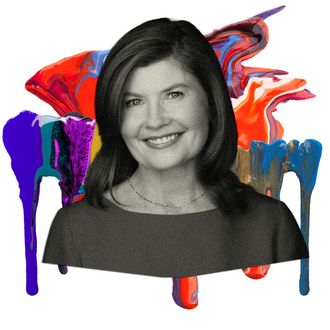
“My greatest goal is to put myself out of work,” says Kris Brown, the president of the gun-safety advocacy group Brady. She first got involved in fighting gun violence 30 years ago as a young legislative assistant in Congress, where she met the organization’s founders, the late Jim and Sarah Brady. Jim, the White House press secretary during the Reagan administration, was permanently disabled after a gunman attempted to assassinate the president in 1981; he and his wife went on to advocate for stricter gun regulations and were the driving force behind the Brady Law, which requires federal background checks for firearm sales.
Brown went on to attend law school and work for nearly two decades in the private sector. After a stint in Switzerland, she decided it was time for a change: She wanted to do work that would make the country better. She joined Brady as a consultant in 2016, and within two years worked her way up to lead the nonprofit organization. “I don’t want my girls to inherit a country that has gun violence as the No. 1 killer of our kids,” she says. “That’s not a free, fair, or reasonable place to live.” Today, Brown lives in Arlington, Virginia, with her partner, Bruce, and their two cats, Abigail and Loki. Here’s how she gets it done.
On her morning routine:
I wake up somewhere between 6 and 7 in the morning. Bruce usually makes me coffee and brings it upstairs. We do the New York Times’ Connections together or the crossword puzzle. I’ll catch up on the news and then either start my day with a Zoom or a phone call. I try to get a workout in before I go to the office; it just depends on what time my official workday starts, somewhere between 8 and 10 a.m. I live about five miles from my office. I bought a car during COVID, a Mini Cooper convertible that I love, and I usually drive her to the office.
On managing stress:
Working out is huge for me. I talk to my daughters regularly — they are away at college. That helps a lot. My mother lives in the town next door, and I talk to her on a daily basis. I also will read; right now I’m reading Trevor Noah’s book, Born a Crime.
On a typical workday:
Almost every day I have a meeting with an outside group that wants to work or partner with Brady. I often have meetings on Capitol Hill too. I have one today with a member of Congress to talk about legislation and how we can best assist in moving important bills forward. I’ll have constant conversations with members of our team and staff; we have 70 people who work full-time for Brady. I have six direct reports, so I check in with them pretty frequently. I also try to have my assistant set aside an hour or two each day when I can catch up on email and do some writing. I publish a lot of op-eds. We’re active in about 30 states, so there’s a lot of strategic decisions to be made about things that come up that tend to not be scheduled. It makes the job super-interesting, because you have to react in real time to things that are happening.
On unwinding at the end of the day:
As I’ve aged, I can have a glass of wine and have a hangover. It’s a terrible thing. So I don’t drink alcohol at all. Cooking is a very relaxing way for me to conclude the day. I love to bake. My favorite thing to bake of late is a Guinness chocolate cake. It’s a Nigella Lawson recipe, and I love her. I’ll give away a lot of the things that I bake because I can’t eat them all myself and nor can Bruce. Music is a huge release too. I like playing the piano. I started taking classes when I was in fifth grade. I strayed away from it for a very long time, but now I have a piano at home and I take lessons once a week. Then I’m usually in bed by 10.
On how she ended up at Brady:
It was mostly serendipity. I worked for Representative Jim Moran on Capitol Hill. That was when Jim and Sarah Brady were spending all of their days lobbying Congress to pass the Brady Law. I worked on the issue of guns and I got to meet them. Then I went to law school and worked in the private sector for 16 years, including as general counsel of a company. I lived in Switzerland with my family.
Then, around 2016, we moved back home. I wanted to do something that was tied to giving back and trying to make America a little better. One of the issues that was really important to me was gun violence. When we lived abroad, I would be asked all the time by people from outside of the U.S., Where can I go and not be shot? It was a sincere question. That’s how the rest of the world thinks about America. Nothing gives you perspective on your own country like living outside of it for a period of time. And I thought, Well, I worked on this issue for a long time in my 20s. I don’t want my girls to inherit a country that has gun violence as the No. 1 killer of our kids. That’s not a free, fair, or reasonable place to live. As luck would have it, Brady wanted help with strategy. I was a consultant, then became its head of policy, and then became president in late 2018.
On the emotional toll of her work:
It doesn’t get any easier to interact and work with gun-violence survivors who’ve suffered horribly and who can’t bring their loved ones back. That’s a uniquely American tragedy. I don’t want to meet people who have suffered in this way. I want to fix the problem. When you run a nonprofit, you exist to put yourself out of business.
It’s very frustrating to see the continued cycle of gun violence play out. I would like it to be that every state across the country has the complement of laws that we know is necessary to save lives. But if I made that my definition of success — I want to pass all of those laws this year in 30 states — I would set myself up to fail. As I have gotten older, and I suppose a little wiser, I’ve really tried to focus on: What can we get done? What’s realistic? What are some stretch goals? Who else do we need to be in coalition with? Who do we need to talk to? For us, success is a single life saved.
On taking care of herself and her staff:
We have what we call healing circles on a monthly basis, where we allow people to just share their feelings about the work. We don’t always have the ability to slow down and really do an inventory about our own reaction to what’s happening. Because our goal is to advance policy, we have work that has to get done, irrespective of the emotional toll. We have a lot of survivors on our staff. Jim and Sarah were survivors, so this is the legacy of our organization. All of America kind of has secondary trauma associated with this epidemic. It’s me, obviously, leading this organization. It’s a kid who just had a lockdown drill at school. It’s a mom who’s dropping her kid at school and wondering if she’ll pick her up. We are trying to move from a place of fear and anger to a place of security, peace, and love.
On the people who help her get it done:
Georgette Brown is my amazing executive assistant and a key leader at Brady. I couldn’t do anything without her. Our chief operating officer, Susan Lavington, helped me really put a lot of order and discipline into how Brady runs. We have a strategic plan and it doesn’t sit on a shelf. Every single person who works at Brady knows where they fit in that plan; we’re very lucky that we have such incredible talent working in our organization. And there’s the friends I’ve made in the movement who are hugely important to me — other survivors who are inspiring to me, like Fred Guttenberg and Kristin Song. They make me want to get up and do this work every day.
This interview has been edited and condensed for length and clarity.


